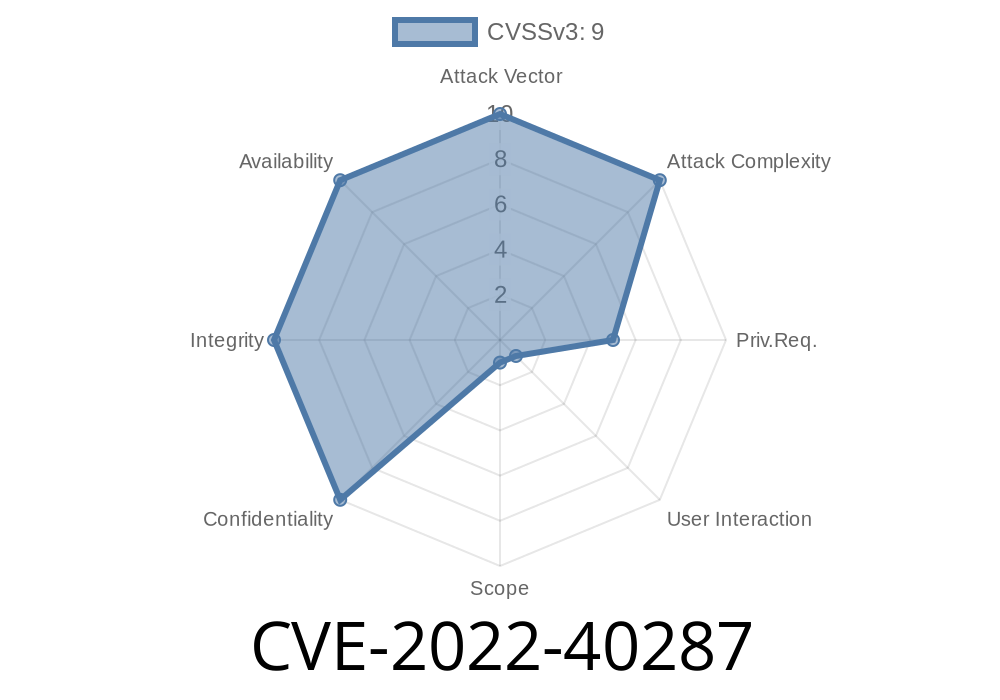In this post, we will analyze and discuss an authenticated Stored Cross-Site Scripting (XSS) vulnerability found in a web application (CVE-2022-40287). This vulnerability specifically affects the application's messaging functionality, potentially leading to privilege escalation or account compromise. We will cover the exploit details, analyzing code snippets, and sharing links to original references to better understand this critical security flaw.
The Vulnerability Overview
The CVE-2022-40287 vulnerability has been identified as an authenticated Stored Cross-Site Scripting (XSS) vulnerability. Stored XSS vulnerabilities occur when malicious input is stored persistently on the target server (such as in a database, message system, or log files) and then executed when a user views the stored content. In this case, the vulnerability exists in the application's messaging functionality, which allows attackers to send malicious messages containing harmful code. When the targeted user opens the malicious message, the embedded code is executed on their browser, leading to the potential of privilege escalation or account compromise.
The following code snippet illustrates the vulnerable messaging functionality
def send_message(request):
if request.method == 'POST':
sender = request.user
recipient = User.objects.get(username=request.POST['recipient'])
message = Message(sender=sender, recipient=recipient, content=request.POST['content'])
message.save()
# Additional code ...
In the above code, we can see that a new Message object is being created using the POST request data, which contains the sender, recipient, and content of the message. The content is directly taken from the user's input without proper sanitization or validation, causing a potential security risk.
The attacker crafts a malicious message containing harmful code, such as
<script>alert('XSS')</script>
The attacker sends the malicious message to the targeted user.
4. When the targeted user opens the message, the harmful code embedded in the message is executed, leading to potential privilege escalation or account compromise.
Mitigation Measures
To protect against this vulnerability, developers must add proper input validation and sanitization. In particular, special HTML characters should be escaped to prevent the execution of harmful code. One way to do this is to use a library specifically designed for secure input handling, such as the OWASP ESAPI project for Python.
from esapi import ESAPI
# ...
def send_message(request):
if request.method == 'POST':
sender = request.user
recipient = User.objects.get(username=request.POST['recipient'])
# Secure content handling:
content = ESAPI.validator().get_valid_input("message_content", request.POST['content'], "SafeString", 200, False)
message = Message(sender=sender, recipient=recipient, content=content)
message.save()
# Additional code ...
Relevant References
1. CVE Details: https://cve.mitre.org/cgi-bin/cvename.cgi?name=CVE-2022-40287
2. Stored XSS (Cross-site Scripting) Prevention Cheat Sheet: https://cheatsheetseries.owasp.org/cheatsheets/Cross_Site_Scripting_Prevention_Cheat_Sheet.html
3. OWASP ESAPI Project for Python: https://owasp.org/www-project-esapi-python/
Conclusion
The CVE-2022-40287 Stored XSS vulnerability in messaging functionality poses a significant security risk. The exploit can potentially lead to privilege escalation or account compromise when exploited. Developers are urged to implement proper input validation and sanitization to safeguard applications against this vulnerability. Stay vigilant, and always prioritize secure coding practices to ensure your applications are free from such security threats.
Timeline
Published on: 10/31/2022 21:15:00 UTC
Last modified on: 11/03/2022 02:13:00 UTC
